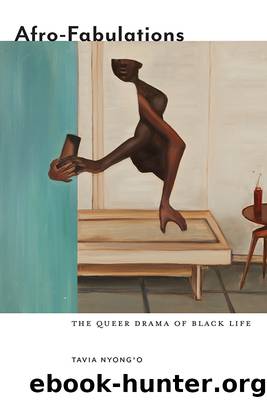Afro-Fabulations by Tavia Nyong'o

Author:Tavia Nyong'o
Language: eng
Format: epub
Tags: ART060000 Art / Performance
Publisher: New York University Press
The Queer Fabulist in the Preternatural Wild
Why track the spoor of race thinking through the theatrical and cinematic wilds? In part, because wildness has emerged as a motif in a coalescing intellectual project interested in moving beyond humanist and state-centered politics and theories.34 Wildness pulls focus away from the human, bringing into sharper relief a background of a pulsing, vital, even queer materiality. Through a “free and wild creation of concepts,” as Deleuze once called for, this new ecological and materialist thought zooms out from human “species being” (as Marx termed it) to access a fuller sweep of events at a planetary and even cosmic level.35 Beasts of the Southern Wild addresses this intellectual moment, articulating our ecological and human challenge in a cinematic language that celebrates the wild, the feral, the autonomous, and the anarchic. The film’s drama turns on our protagonist confronting the fearsome power of the aurochs, a power she initially fears will devour her, and realizing that its wildness is the true source of her strength. It is worth thinking through how this plot resonates with what Grégoire Chamayou has named “cynegetic power”: a biopolitical power constituted around the right to make other humans prey.36 Beasts evokes such cynegetic power when the aurochs are set up as a confabulation of the forces that are steadily encroaching on the Bathtub. Hushpuppy’s capacity to fabricate the aurochs as animate agents allows her to harness their strength in her fugitive quest to escape the internment camp that would “civilize” her. Her biophilic affiliations allow her to join the beasts somewhere “below the law.” But is that where the aurochs ever were?
Beasts of the Southern Wild takes its place in an aesthetic and scientific series of contexts in which the aurochs is a surrogate for modernist and postmodernist fantasies of reclaimed land, wildness, violence, and freedom. It underscores how running with the aurochs can induce what Diane Chisholm calls a “biophilia”: an attraction to a landscape so strong it resembles “an outlaw coupling, the wild anarchy of a love affair whose heated obsession betray[s] and unravel[s] some other, weaker, fidelity.”37 This wild perception of nature as something that possesses one, an environment in which one might be eaten as well as eat, may appear a heady way to slip the yoke of human difference. But the freedom of the indirect images through which cinema viewers find themselves immersed in Hushpuppy’s landscape is not racially unmarked. The preternatural aurochs do not merely descend on the Bathtub from a future climate collapse, as patched together by the traumatized imagination of a child. When they appear on-screen, they also reveal what Deleuze called their “dark precursors”: the “invisible, imperceptible” historical intensities that “determines their path in advance, but in reverse, as though intagliated.”38 Alibar herself has stated, “I don’t know where the herd of aurochs came from.”39 This “nowhere” is precisely the location of the dark precursor I discuss in more detail in the next chapter. The film attributes the genesis of Hushpuppy’s fabulation to the traumatic sight of an aurochs tattoo on the thigh of her teacher, Miss Bathsheba.
Download
This site does not store any files on its server. We only index and link to content provided by other sites. Please contact the content providers to delete copyright contents if any and email us, we'll remove relevant links or contents immediately.
| African-American Studies | Asian American Studies |
| Disabled | Ethnic Studies |
| Hispanic American Studies | LGBT |
| Minority Studies | Native American Studies |
Cecilia; Or, Memoirs of an Heiress — Volume 1 by Fanny Burney(32436)
Cecilia; Or, Memoirs of an Heiress — Volume 2 by Fanny Burney(31872)
Cecilia; Or, Memoirs of an Heiress — Volume 3 by Fanny Burney(31857)
The Great Music City by Andrea Baker(31368)
We're Going to Need More Wine by Gabrielle Union(18970)
All the Missing Girls by Megan Miranda(15582)
Pimp by Iceberg Slim(14397)
Bombshells: Glamour Girls of a Lifetime by Sullivan Steve(13977)
Talking to Strangers by Malcolm Gladwell(13225)
Norse Mythology by Gaiman Neil(13210)
Fifty Shades Freed by E L James(13158)
For the Love of Europe by Rick Steves(13034)
Mindhunter: Inside the FBI's Elite Serial Crime Unit by John E. Douglas & Mark Olshaker(9206)
Crazy Rich Asians by Kevin Kwan(9170)
The Lost Art of Listening by Michael P. Nichols(7409)
Enlightenment Now: The Case for Reason, Science, Humanism, and Progress by Steven Pinker(7238)
The Four Agreements by Don Miguel Ruiz(6636)
Bad Blood by John Carreyrou(6553)
Weapons of Math Destruction by Cathy O'Neil(6147)
